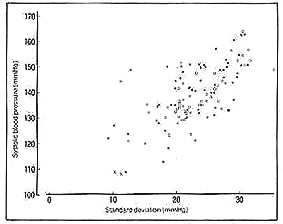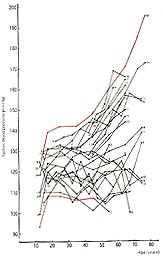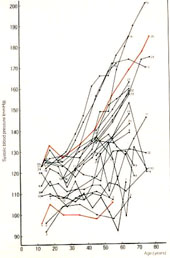Salt and Hypertension
Naosuke Sasaki
 ( Pfizer SPECTRUM International Volume XXII Number
4 ,60-64, 1979)
Homo sapiens may indeed be the only existing species
of man but, as we all know, the variety concealed within that
definition is almost infinitely variable. Many of these variations
are simply intriguing or add spice to life, but others have considerable
bearing on the well-being of mankind - and among these is variation
in blood-pressure. It is well-known fact that blood-pressure levels
vary not only between different peoples but also within the same
population groups;what is not known is why they vary. International
epidemiological studies are still few but a start has been made
and clues that we possess from existing data may soon lead to
established fact.
・・・・
Experimental evidence
・・・・
Mechanical of action
・・・・
Epidemiological stugdies
( Pfizer SPECTRUM International Volume XXII Number
4 ,60-64, 1979)
Homo sapiens may indeed be the only existing species
of man but, as we all know, the variety concealed within that
definition is almost infinitely variable. Many of these variations
are simply intriguing or add spice to life, but others have considerable
bearing on the well-being of mankind - and among these is variation
in blood-pressure. It is well-known fact that blood-pressure levels
vary not only between different peoples but also within the same
population groups;what is not known is why they vary. International
epidemiological studies are still few but a start has been made
and clues that we possess from existing data may soon lead to
established fact.
・・・・
Experimental evidence
・・・・
Mechanical of action
・・・・
Epidemiological stugdies
 Fig.1 Mean values and ranges of distribution of the
systolic blood pressure in 50 year-old men in various population(・Japanese
men from the north-east of Japan. 0Japanese men from the south-west
of Japan.*Men from other population throughout the world)
Figure 1 shows a comparison of mean systolic blood
pressure levels and range of distribution between two groups of
50-year-old Japanese men and 50-year-old men from varoius populations
in other parts of the world. The bias against the Japanese men
is evident, especially those from the north-east of the country
among whom the mean systolic pressure are high and range of distribution
wide.
In an attempt to explain these differences - and in
particular the differences between the two Japanese populatoions
- I personally measured the blood pressures of various group in
the north-east of Japan, since in any epidemiological investigation
such as this it is essential to carry out mass measurements and
discover the distribution of the blood pressure levels within
the population. The investigation then proceeded towards an analysis
of the possible causes of the differences in the blood pressures
of the various groups and the differences in individual blood
pressures. I first examined the relationship between blood pressure
and living conditions and then, to explain the differences in
blood pressure levels, I proposed as a working hypothesis the
differences in daily salt intake.
The blood pressure of Homo sapiens varies from a low
level with a narrow range of distribution, remaining so throughout
life(the natives of Brazil and New Guines), to a high level with
a wider distribution begining in childhood and progressing with
age to higher distribution(the inhabitants of north-east Japan).
The correlation between blood pressure(both level and distribution)and
daily salt intake is striking.
Fig.1 Mean values and ranges of distribution of the
systolic blood pressure in 50 year-old men in various population(・Japanese
men from the north-east of Japan. 0Japanese men from the south-west
of Japan.*Men from other population throughout the world)
Figure 1 shows a comparison of mean systolic blood
pressure levels and range of distribution between two groups of
50-year-old Japanese men and 50-year-old men from varoius populations
in other parts of the world. The bias against the Japanese men
is evident, especially those from the north-east of the country
among whom the mean systolic pressure are high and range of distribution
wide.
In an attempt to explain these differences - and in
particular the differences between the two Japanese populatoions
- I personally measured the blood pressures of various group in
the north-east of Japan, since in any epidemiological investigation
such as this it is essential to carry out mass measurements and
discover the distribution of the blood pressure levels within
the population. The investigation then proceeded towards an analysis
of the possible causes of the differences in the blood pressures
of the various groups and the differences in individual blood
pressures. I first examined the relationship between blood pressure
and living conditions and then, to explain the differences in
blood pressure levels, I proposed as a working hypothesis the
differences in daily salt intake.
The blood pressure of Homo sapiens varies from a low
level with a narrow range of distribution, remaining so throughout
life(the natives of Brazil and New Guines), to a high level with
a wider distribution begining in childhood and progressing with
age to higher distribution(the inhabitants of north-east Japan).
The correlation between blood pressure(both level and distribution)and
daily salt intake is striking.

 Fig.2&3. Mean systolic blood pressure among among
males and females of different groups listed Table 1.
Figure 2 and 3 show the mean systolic blood pressure
levels by age and sex among the populations whose daily salt intake
was actually measured.
Table 1.
No. Regions Groups Daily salt intake Reference
1 Brazil Yanomamo No-salt culture Oliver et al.(1975.)
2 Brazil Carajas No table salt(plant ashes) Lowenstein(1961)
3 Mundurgus Regural use of table salt
4 New Guinea Highlan natives little or no salt(1.7g)
White(1958)
5 Coastal natives Do not lack salt
6 Solomon Island Bargu 0.6-1.7g Page et al.(1974)
7 Aita 0.6-1.7g
8 Kwaio <1.2g
9 Nasioi 2.9-7.5g
10 Nagovisi 2.9-7.5g
11 lau 8.7-13.3g
12 South Pacific Pukapukans 2.9-4.1g Prior et al.(1968)
13 Rarotonga 7.0-8.2g
14 India Agra 6-10g Mathur et al.(1963)
15 South Wales Rhonda Fach 8g Mial and Oldham(1958)
16 West Indies(St.Kitts) Negro 10g Schneckloth
et al.(1962)
17 USA Framinham 10g Kagan et al.(1959)
18 Bahamas Negro 15-30g Moser et al.(1959)
19 Japan Yao,Osaka 13g Shigiya et al.(1975)
20 Kochi 18g
21 Hirai.Gunma 22g
22 Nagano 22.1g
23 Akita 20g
24 Japan North-east(warmer season) >20g Sasaki(1962)
25 North-east(colder season) >20g
The blood pressure was high at a young age among those
peoples whose salt intake was above 10 g per day and it continued
to rise with increasing age. In constract, those peoples whose
salt intake was below 5 g per day have a low blood pressure when
young and showed no increase with age. It may seem strange to
a non-Japanese reader that Japanese people, particularly those
from the north-east, consumed between 20-30 g of salt a day, but
the explanation lies in their long-established eating habits.(Sasaki,N.:Jpn.Heart.J.,3,313,1962.)
The majority of the population in north-east Japan
are farmers who take their salt in five main forms:soy-sauce,
seasoning or table salt, "miso", pickles, other foods.
Miso is made from soy beans, yeast, and salt(which amounts to
7-12 % of the miso). Japanese people serve miso soup(on average
a 1.5 % salt solution) three times a day. A cup usually contains
150-200 ml and three times or four cupfuls are other taken a time.
Japanese farmers, therefore, consume about 6.5 g of salt a day
from miso soup alone. Add to this their predilection for pickled
raddish(2 g of salt per 100 g) and soy sauce(18 g of salt per
100 ml) and it is not difficult to see how farmers in the north-east
of Japan can consume 27 g salt a day. Field surveys have shown
that these men can excrete more than 50 g of salt per day in their
urine.
Epidemiological studies of hypertension among the natives
of the Bahamas (Moser,m. et al.:Am.J.Card.,4,727,1959.)have shown
that the diet on the smaller islands consisted primarily of peas,
rice and fish. Much of the food was fried in salt pork oil but
little or no meat was available as a souce protein. The fish was
usually salted and preserved by drying in the sun. Moreover, most
well water on the islands has an extremely high sodium content
of 100-150 mg per 100 ml compared with the average sodium content
of the domestic water supply in the USA of 0.3-0.4 mg per 100
ml. In consequence the inhabitants of the island consumed 15-30
g of salt per person per day. Their mean systolic blood pressure
levels were high and most frequent complication of hypertension
was cerebral haemorrhage. It is noteworthy that the pattern of
hypertension and cerebrovascular accidents in the Bahamas is similar
to that in the Akita prefecture of Japan.
The latest report on the Solomon islanders (Page,l.B.
et al.:Circulation,49,1132,1974.)showed that the trends of blood
pressure level among six different tribes correlated well with
differeces in the diet, especially the salt intake. Of considerable
interest is the observation that salt intake was much greater in
the more acculturated("civilized")tribes. The fact that
these people had higher blood pressure than the unacculturated
tribes seems to suggest that there is probably no such thing as
genetic immunity from hypertension. Nevertheless, there were
hypertensions as, for example, among the unacculturated Lau tribes
who had a high salt intake as a result of their habit of cooking
their vegetables in sea water - they had high mean systolic blood
pressures.
Only recently has it been discovered that there are,
on the one hand, people who take extreme amounts of salt in their
diet and, on the other hand, people who take very little salt
indeed. Oliver and his collegues(Circulation,52,146,1975.) have
acquired data on Yanomamo Indians, an unacculturated tribes inhabting
the tropical rain forest of northern Brazil and southern Venezuela
who live in a "no-salt" culture. The blood pressure
of these Indians increased from the first to secade of life but,
in contrast to the pattern in cicilized population, it did not
increase systematically during subsequent year. The blood pressure
in adult life was 100 mmHg and their mean diastolic pressure was
60 mmHg. In view of these findings, Oliver and his colleagues
suggested that the customary quantities of salt in contemporary
diets far exceeded the amount necessary to maintain sodium balance
and resulted in depressed levels of the sodium-related hormones,
renin and aldosterone. These observations on an unculturated people
provide further support for the late Lewis Dahl's conclusion that
in civilized societies "salt appetites is not to be equated
with salt requirement".
Fig.2&3. Mean systolic blood pressure among among
males and females of different groups listed Table 1.
Figure 2 and 3 show the mean systolic blood pressure
levels by age and sex among the populations whose daily salt intake
was actually measured.
Table 1.
No. Regions Groups Daily salt intake Reference
1 Brazil Yanomamo No-salt culture Oliver et al.(1975.)
2 Brazil Carajas No table salt(plant ashes) Lowenstein(1961)
3 Mundurgus Regural use of table salt
4 New Guinea Highlan natives little or no salt(1.7g)
White(1958)
5 Coastal natives Do not lack salt
6 Solomon Island Bargu 0.6-1.7g Page et al.(1974)
7 Aita 0.6-1.7g
8 Kwaio <1.2g
9 Nasioi 2.9-7.5g
10 Nagovisi 2.9-7.5g
11 lau 8.7-13.3g
12 South Pacific Pukapukans 2.9-4.1g Prior et al.(1968)
13 Rarotonga 7.0-8.2g
14 India Agra 6-10g Mathur et al.(1963)
15 South Wales Rhonda Fach 8g Mial and Oldham(1958)
16 West Indies(St.Kitts) Negro 10g Schneckloth
et al.(1962)
17 USA Framinham 10g Kagan et al.(1959)
18 Bahamas Negro 15-30g Moser et al.(1959)
19 Japan Yao,Osaka 13g Shigiya et al.(1975)
20 Kochi 18g
21 Hirai.Gunma 22g
22 Nagano 22.1g
23 Akita 20g
24 Japan North-east(warmer season) >20g Sasaki(1962)
25 North-east(colder season) >20g
The blood pressure was high at a young age among those
peoples whose salt intake was above 10 g per day and it continued
to rise with increasing age. In constract, those peoples whose
salt intake was below 5 g per day have a low blood pressure when
young and showed no increase with age. It may seem strange to
a non-Japanese reader that Japanese people, particularly those
from the north-east, consumed between 20-30 g of salt a day, but
the explanation lies in their long-established eating habits.(Sasaki,N.:Jpn.Heart.J.,3,313,1962.)
The majority of the population in north-east Japan
are farmers who take their salt in five main forms:soy-sauce,
seasoning or table salt, "miso", pickles, other foods.
Miso is made from soy beans, yeast, and salt(which amounts to
7-12 % of the miso). Japanese people serve miso soup(on average
a 1.5 % salt solution) three times a day. A cup usually contains
150-200 ml and three times or four cupfuls are other taken a time.
Japanese farmers, therefore, consume about 6.5 g of salt a day
from miso soup alone. Add to this their predilection for pickled
raddish(2 g of salt per 100 g) and soy sauce(18 g of salt per
100 ml) and it is not difficult to see how farmers in the north-east
of Japan can consume 27 g salt a day. Field surveys have shown
that these men can excrete more than 50 g of salt per day in their
urine.
Epidemiological studies of hypertension among the natives
of the Bahamas (Moser,m. et al.:Am.J.Card.,4,727,1959.)have shown
that the diet on the smaller islands consisted primarily of peas,
rice and fish. Much of the food was fried in salt pork oil but
little or no meat was available as a souce protein. The fish was
usually salted and preserved by drying in the sun. Moreover, most
well water on the islands has an extremely high sodium content
of 100-150 mg per 100 ml compared with the average sodium content
of the domestic water supply in the USA of 0.3-0.4 mg per 100
ml. In consequence the inhabitants of the island consumed 15-30
g of salt per person per day. Their mean systolic blood pressure
levels were high and most frequent complication of hypertension
was cerebral haemorrhage. It is noteworthy that the pattern of
hypertension and cerebrovascular accidents in the Bahamas is similar
to that in the Akita prefecture of Japan.
The latest report on the Solomon islanders (Page,l.B.
et al.:Circulation,49,1132,1974.)showed that the trends of blood
pressure level among six different tribes correlated well with
differeces in the diet, especially the salt intake. Of considerable
interest is the observation that salt intake was much greater in
the more acculturated("civilized")tribes. The fact that
these people had higher blood pressure than the unacculturated
tribes seems to suggest that there is probably no such thing as
genetic immunity from hypertension. Nevertheless, there were
hypertensions as, for example, among the unacculturated Lau tribes
who had a high salt intake as a result of their habit of cooking
their vegetables in sea water - they had high mean systolic blood
pressures.
Only recently has it been discovered that there are,
on the one hand, people who take extreme amounts of salt in their
diet and, on the other hand, people who take very little salt
indeed. Oliver and his collegues(Circulation,52,146,1975.) have
acquired data on Yanomamo Indians, an unacculturated tribes inhabting
the tropical rain forest of northern Brazil and southern Venezuela
who live in a "no-salt" culture. The blood pressure
of these Indians increased from the first to secade of life but,
in contrast to the pattern in cicilized population, it did not
increase systematically during subsequent year. The blood pressure
in adult life was 100 mmHg and their mean diastolic pressure was
60 mmHg. In view of these findings, Oliver and his colleagues
suggested that the customary quantities of salt in contemporary
diets far exceeded the amount necessary to maintain sodium balance
and resulted in depressed levels of the sodium-related hormones,
renin and aldosterone. These observations on an unculturated people
provide further support for the late Lewis Dahl's conclusion that
in civilized societies "salt appetites is not to be equated
with salt requirement".
Conclusion
Thus from the epidemiological viewpoint it seems that
the level and distribution pattern of the blood pressure of a
population are related to the daily salt intake which is determined
by dietary habit from childhood. But epidemiological evidence
also shows that Homo sapiens survive on very low intakes of salt.
In fact, it now appears that the basal requirement of sodium is
only about 0.2 g per day and that even in conditions of extreme
demand for salt(sweating 8-9 liters per day) the requirement does
not rise above 2 g per day. Human physiology can soon adapted
to daily intakes of less than 1 g per day and after a few weeks
even the "civilized" palate becomes fully adjusted.
もとへもどる